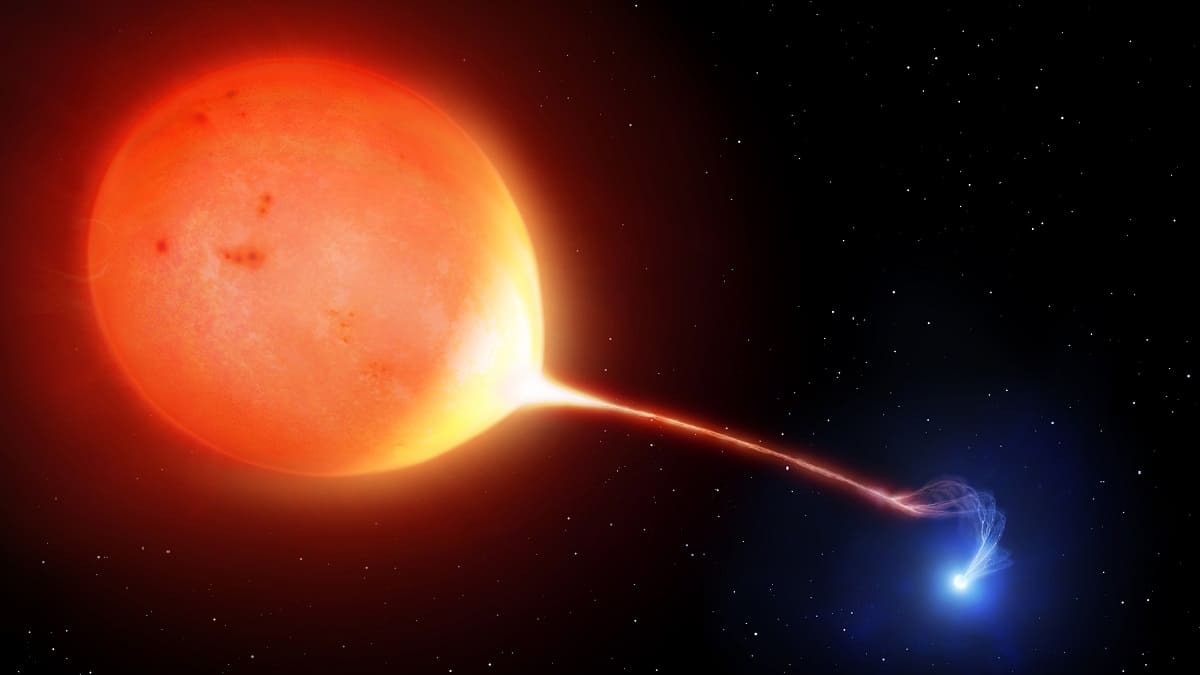21.10.2022
The two stars orbit each other every 51 minutes and confirm a long-debated theory about whether this could even be possible.

A binary star system with the shortest orbit ever witnessed has been discovered by astronomers.
The system is believed to be one of a rare class of binaries known as a “cataclysmic variable.” These systems include one star roughly the size of our own sun, orbiting around a white dwarf – the hot, dense core of a burned-out star.
Nearly half the stars in the Milky Way are solitary, like our sun. The rest appear in pairs or multiples, orbiting around each other. Often these orbits are so tight, that some stellar systems could fit between Earth and the moon.
Cataclysmic binaries form as the two stars come closer together over billions of years. The denser white dwarf starts accreting – consuming material of the other star. This process can result in occasional, enormous flashes of light, assumed by astronomers centuries ago to be due to some unknown cataclysm.
The newly discovered system has been named ZTF J1813+4251. The system resides about 3,000 light years from Earth in the Hercules constellation. At 51 minutes, the orbit of the stellar pair is the shortest cataclysmic variable orbit detected. The discovery is reported in Nature.
As the stars eclipsed each other, the astronomers were able to precisely measure the properties of each star.
With their calculations, the astronomers were able to run simulations of how the system is evolving. They conclude that the stars will migrate closer, in 70 million years orbiting each other every 18 minutes, before beginning to expand and drift apart.
Currently, the stars are in a transition – the sun-like star has been stripped of much of its hydrogen atmosphere, eventually reducing to its mostly dense, helium-rich core.
“This is a rare case where we caught one of these systems in the act of switching from hydrogen to helium accretion,” says first author Dr Kevin Burdge from MIT. “People predicted these objects should transition to ultrashort orbits, and it was debated for a long time whether they could get short enough to emit detectable gravitational waves. This discovery puts that to rest.”
The new system was discovered within a vast catalogue of stars, observed by the Zwicky Transient Facility (ZTF) – a survey that uses a camera attached to a telescope at the Palomar Observatory in California.
The survey has taken more than 1,000 images of each of the more than 1 billion stars in the sky, recording each star’s changing brightness over days, months, and years.
Burdge combed through the data, looking for signs of ultrashort orbits like dramatic bursts of light and gravitational waves. “Gravitational waves are allowing us to study the universe in a totally new way,” says Burdge.
“This thing popped up, where I saw an eclipse happening every 51 minutes, and I said, OK, this is definitely a binary,” Burdge recalls.
Using the W.M. Keck Observatory in Hawaiʻi and the Gran Telescopio Canarias in Spain, the team focused on the new binary. The “clean” pictures of the stars passing over each other meant they were able to accurately measure their properties.
They found that the first object was likely a white dwarf, with a diameter 1% that of our sun and half its mass. The second object was a sun-like star near the end of its life, at a tenth the size and mass of the sun (about the size of Jupiter).
But it shouldn’t be possible for the sun-like star to orbit this quickly.
“This one star looked like the sun, but the sun can’t fit into an orbit shorter than eight hours – what’s up here?” Burdge asked? It was then that Budge and colleagues realised that this must be a cataclysmic variable, confirming a decades-long theory.
As the sun-like star is stripped down to its core, it remains heavy and dense enough to keep the dead star in an ultrashort orbit.
“This is a special system,” Burdge says. “We got doubly lucky to find a system that answers a big open question, and is one of the most beautifully behaved cataclysmic variables known.”
Quelle: COSMOS
